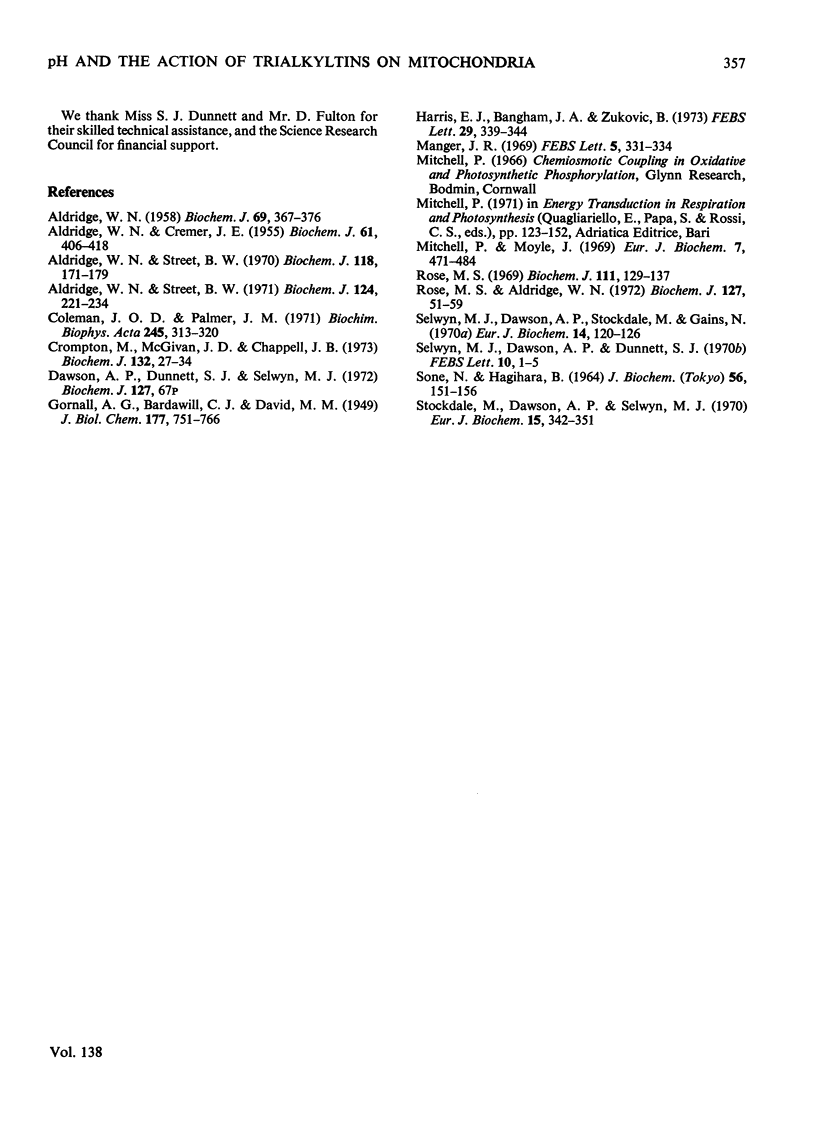Abstract
1. Inhibition of 2,4-dinitrophenol-stimulated respiration by trialkyltins is dependent on the presence of Cl− in the assay medium and is only apparent at acid pH values. It appears to be a result of the Cl−–OH− exchange mediated by trialkyltins. 2. In a KCl medium at alkaline pH values, the maximum rate of respiration produced by uncouplers is further increased by the presence of trialkyltins. 3. The inhibition of uncoupled succinate oxidation at acid pH values is not reversed by increasing the external substrate concentration, suggesting that depletion of intramitochondrial succinate is not an important factor in the inhibition. 4. It is suggested that the probable explanation for these observations is that in the presence of Cl− trialkyltins alter the internal pH to a more acid value and this directly affects the activity of one or more steps in succinate oxidation. 5. The oligomycin-like action of trialkyltins in a Cl−-free medium shows considerable pH-dependence over the pH range 6.6–7.6 in the presence of 10mm-phosphate, but very much less pH-dependence in the presence of 1mm-phosphate. 6. The binding of triethyltin to mitochondria shows a pK at pH6.3 and does not change greatly over the pH range 6.6–7.6. 7. It is suggested that the pH-dependence of the oligomycin-like action described by Coleman & Palmer (1971) is the result of the pH-dependence of the formation of a hydrophilic complex between trialkyltins and Pi.
Full text
PDF








Selected References
These references are in PubMed. This may not be the complete list of references from this article.
- ALDRIDGE W. N., CREMER J. E. The biochemistry of organo-tin compounds; diethyltin dichloride and triethyltin sulphate. Biochem J. 1955 Nov;61(3):406–418. doi: 10.1042/bj0610406. [DOI] [PMC free article] [PubMed] [Google Scholar]
- ALDRIDGE W. N. The biochemistry of organotin compounds: trialkyltins and oxidative phosphorylation. Biochem J. 1958 Jul;69(3):367–376. doi: 10.1042/bj0690367. [DOI] [PMC free article] [PubMed] [Google Scholar]
- Aldridge W. N., Street B. W. Oxidative phosphorylation. The relation between the specific binding of trimethylytin and triethyltin to mitochondria and their effects on various mitochondrial functions. Biochem J. 1971 Aug;124(1):221–234. doi: 10.1042/bj1240221. [DOI] [PMC free article] [PubMed] [Google Scholar]
- Aldridge W. N., Street B. W. Oxidative phosphorylation. The specific binding of trimethyltin and triethyltin to rat liver mitochondria. Biochem J. 1970 Jun;118(1):171–179. doi: 10.1042/bj1180171. [DOI] [PMC free article] [PubMed] [Google Scholar]
- Coleman J. O., Palmer J. M. The influence of pH on the inhibition of oxidative phosphorylation and electron transport by triethyltin. Biochim Biophys Acta. 1971 Sep 7;245(2):313–320. doi: 10.1016/0005-2728(71)90150-2. [DOI] [PubMed] [Google Scholar]
- Crompton M., McGivan J. D., Chappell J. B. The intramitochondrial location of the glutaminase isoenzymes of pig kidney. Biochem J. 1973 Jan;132(1):27–34. doi: 10.1042/bj1320027. [DOI] [PMC free article] [PubMed] [Google Scholar]
- Harris E. J., Bangham J. A., Zukovic B. Equilibration of chloride and pyruvate distributions between liver mitochondria and medium mediated by organo-tin salts. FEBS Lett. 1973 Feb 1;29(3):339–344. doi: 10.1016/0014-5793(73)80054-7. [DOI] [PubMed] [Google Scholar]
- Manger J. R. The effect of triethyltin on mitochondrial ion accumulation. FEBS Lett. 1969 Dec 30;5(5):331–334. doi: 10.1016/0014-5793(69)80349-2. [DOI] [PubMed] [Google Scholar]
- Mitchell P., Moyle J. Estimation of membrane potential and pH difference across the cristae membrane of rat liver mitochondria. Eur J Biochem. 1969 Feb;7(4):471–484. doi: 10.1111/j.1432-1033.1969.tb19633.x. [DOI] [PubMed] [Google Scholar]
- Rose M. S., Aldridge W. N. Oxidative phosphorylation. The effect of anions on the inhibition by triethyltin of various mitochondrial functions, and the relationship between this inhibition and binding of triethyltin. Biochem J. 1972 Mar;127(1):51–59. doi: 10.1042/bj1270051. [DOI] [PMC free article] [PubMed] [Google Scholar]
- Rose M. S. Evidence for histidine in the triethyltin-binding site of rat haemoglobin. Biochem J. 1969 Jan;111(2):129–137. doi: 10.1042/bj1110129. [DOI] [PMC free article] [PubMed] [Google Scholar]
- SONE N., HAGIHARA B. INHIBITORY ACTION OF TRIALKYLTIN COMPOUNDS ON OXIDATIVE PHOSPHORYLATION IN MITOCHONDRIA. J Biochem. 1964 Aug;56:151–156. doi: 10.1093/oxfordjournals.jbchem.a127972. [DOI] [PubMed] [Google Scholar]
- Selwyn M. J., Dawson A. P., Dunnett S. J. Calcium transport in mitochondria. FEBS Lett. 1970 Sep 18;10(1):1–5. doi: 10.1016/0014-5793(70)80402-1. [DOI] [PubMed] [Google Scholar]
- Selwyn M. J., Dawson A. P., Stockdale M., Gains N. Chloride-hydroxide exchange across mitochondrial, erythrocyte and artificial lipid membranes mediated by trialkyl- and triphenyltin compounds. Eur J Biochem. 1970 May 1;14(1):120–126. doi: 10.1111/j.1432-1033.1970.tb00268.x. [DOI] [PubMed] [Google Scholar]
- Stockdale M., Dawson A. P., Selwyn M. J. Effects of trialkyltin and triphenyltin compounds on mitochondrial respiration. Eur J Biochem. 1970 Aug;15(2):342–351. doi: 10.1111/j.1432-1033.1970.tb01013.x. [DOI] [PubMed] [Google Scholar]


